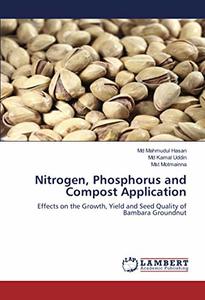Citation
Hasan, Mahmudul and Uddin, Md. Kamal and Motmainna, Mst
(2020)
Nitrogen, phosphorus and compost application: effects on growth, yield and seed quality of bambara groundnut.
LAP LAMBERT Academic Publishing.
ISBN 6139984866/9786139984862
Abstract
Bambara groundnut (Vigna subterranea) is an indigenous African crop. Its seeds contain 63% carbohydrate, 19% protein, 6.5% oil and good source of fibre, calcium, iron and potassium. Hence, this study aimed to determine the effect of nitrogen (N), phosphorus (P) and compost on growth, yield and seed quality of bambara groundnut. Two pot experiments were conducted in Ladang15 at the Faculty of Agriculture, Universiti Putra Malaysia. Both of the experiments were arranged in a Randomized Complete Block Design. The first experiment was conducted in a factorial design with four levels of N (0, 10, 20, 30 kg ha-1) and P (0, 20, 40 and 60 kg ha-1). The second experiment was conducted using different levels of nitrogen, phosphorus, compost, biofertilizer and gypsum. Mineral composition of the seed was determined by dry ashing method. Amino acid content in the seed was determined by HPLC. In the first experiment, the vegetative growth of the plant i.e. plant height (20.65 cm), leaves number (262), branch number (86.50) and leaf area (2140.54 cm2) was attained at N and P (N30 + P60 kg ha-1) application. The maximum pod number per plant (47.25) was attained in the treatment of T16 (N30 and P60 kg ha-1) i.e. the highest amount of N and P application. From the results, it is revealed that the seed of bambara groundnut contains 20.30% protein, 5.01% fibre, cysteine 11.3 mg kg-1, alanine 42.5 mg kg-1, 663.3 mg kg-1 Ca, and 650.5 mg kg-1 Mg. In the second experiment, compost, biofertilizer, gypsum was used along with the combination of N and P (two best treatments from the first study and also recommended dose of N and P). In this study, N and P fertilizers played dominating role for vegetative growth of the plant. Plant height (21.73 cm), leaves number (265.50) and leaf area (2802.9 cm2) increased with the application of highest level of N and P i.e. T1 (control) (N30 + P60 kg ha-1) application. The maximum number of pod (41.75) and highest pod weight (49.68 g) were also attained by T1 (N30 + P60 kg ha-1). Protein 19.95%, fiber 5.20%, histidine 30 mg kg-1, methionine 14.8 mg kg-1, potassium 448.8 mg kg-1 and manganese 24.4 mg kg-1 were contained in the seed of bambara groundnut. From the two experiments, it is presented that application of compost and different levels of fertilizer had no major changes in the nutritional value of bambara groundnut. However, the application of N30 and P60 kg ha-1 fertilizer, vegetative growth and yield of the plant was better than all other treatments in both experiments. For getting maximum growth, yield and seed quality of bambara groundnut N30 kg ha-1 and P60 kg ha-1 could be recommended.
Download File
Additional Metadata
Actions (login required)
 |
View Item |


![[img]](http://psasir.upm.edu.my/78606/1.hassmallThumbnailVersion/Nitrogen%2C%20Phosphorus%20and%20Compost%20Application%20Effects%20on%20Growth%2C%20Yield%20and%20Seed%20Quality%20of%20Bambara%20Groundnut.jpg)
